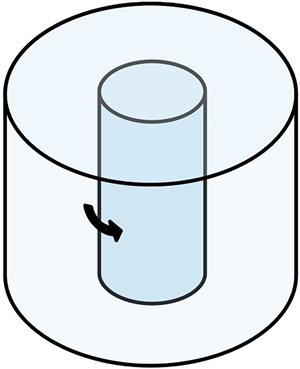Article contents
Exact relations between Rayleigh–Bénard and rotating plane Couette flow in two dimensions
Published online by Cambridge University Press: 28 September 2020
Abstract

Rayleigh–Bénard convection (RBC) and Taylor–Couette flow (TCF) are two paradigmatic fluid dynamical systems frequently discussed together because of their many similarities despite their different geometries and forcing. Often these analogies require approximations, but in the limit of large radii where TCF becomes rotating plane Couette flow (RPC) exact relations can be established. When the flows are restricted to two spatial independent variables, there is an exact specification that maps the three velocity components in RPC to the two velocity components and one temperature field in RBC. Using this, we deduce several relations between both flows: (i) heat and angular momentum transport differ by  $(1-R_{\Omega })$, explaining why angular momentum transport is not symmetric around
$(1-R_{\Omega })$, explaining why angular momentum transport is not symmetric around  $R_{\Omega }=1/2$ even though the relation between
$R_{\Omega }=1/2$ even though the relation between  $Ra$, the Rayleigh number, and
$Ra$, the Rayleigh number, and  $R_{\Omega }$, a non-dimensional measure of the rotation, has this symmetry. This relationship leads to a predicted value of
$R_{\Omega }$, a non-dimensional measure of the rotation, has this symmetry. This relationship leads to a predicted value of  $R_{\Omega }$ that maximizes the angular momentum transport that agrees remarkably well with existing numerical simulations of the full three-dimensional system. (ii) One variable in both flows satisfies a maximum principle, i.e. the fields’ extrema occur at the walls. Accordingly, backflow events in shear flow cannot occur in this quasi two-dimensional setting. (iii) For free-slip boundary conditions on the axial and radial velocity components, previous rigorous analysis for RBC implies that the azimuthal momentum transport in RPC is bounded from above by
$R_{\Omega }$ that maximizes the angular momentum transport that agrees remarkably well with existing numerical simulations of the full three-dimensional system. (ii) One variable in both flows satisfies a maximum principle, i.e. the fields’ extrema occur at the walls. Accordingly, backflow events in shear flow cannot occur in this quasi two-dimensional setting. (iii) For free-slip boundary conditions on the axial and radial velocity components, previous rigorous analysis for RBC implies that the azimuthal momentum transport in RPC is bounded from above by  $Re_S^{5/6}$, where
$Re_S^{5/6}$, where  $Re_S$ is the shear Reynolds number, with a scaling exponent smaller than the anticipated
$Re_S$ is the shear Reynolds number, with a scaling exponent smaller than the anticipated  $Re_S^1$.
$Re_S^1$.
- Type
- JFM Rapids
- Information
- Copyright
- © The Author(s), 2020. Published by Cambridge University Press
References
REFERENCES
- 5
- Cited by





